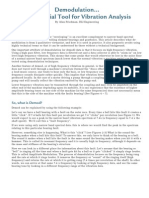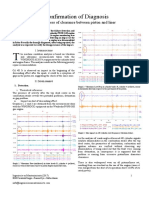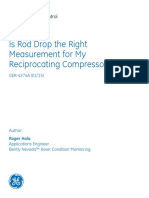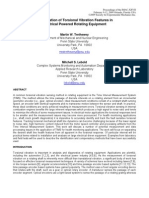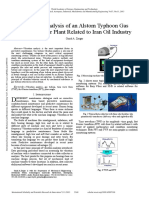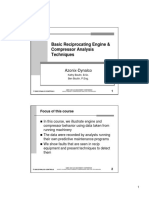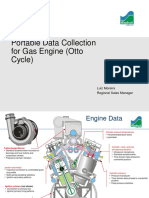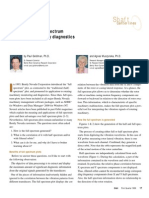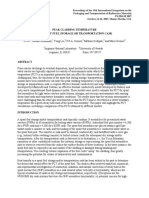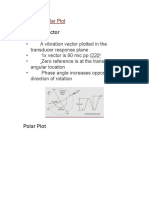Leak Index Customization - Apergy
Leak Index Customization - Apergy
Uploaded by
Muhammad HaroonCopyright:
Available Formats
Leak Index Customization - Apergy
Leak Index Customization - Apergy
Uploaded by
Muhammad HaroonOriginal Title
Copyright
Available Formats
Share this document
Did you find this document useful?
Is this content inappropriate?
Copyright:
Available Formats
Leak Index Customization - Apergy
Leak Index Customization - Apergy
Uploaded by
Muhammad HaroonCopyright:
Available Formats
Leak Index Customization
1 Confidential Apergy Information – May not be copied or distributed
outside of Apergy. Copyright 2018 Apergy. All rights reserved.
Leak Index Customization
Overview
When is it appropriate to adjust?
Customizing
– Smoothing Factor
– Leak Index Window
– Sensitivity
Considerations when making adjustments
2 Confidential Apergy Information – May not be copied or distributed
outside of Apergy. Copyright 2018 Apergy. All rights reserved.
Leak Index Overview
Windrock Newsletter - Pro Tip: Leak Index
The Leak Index is a proprietary feature of Windrock software that provides the user with
an automated diagnosis of leakage within a compressor cylinder.
The Leak Index is able to identify valve leakage, both suction and discharge, as well as
packing and ring leakage.
In addition to finding the fault, Leak Index assigns a severity level to the problem and
gives a visual reference of the leak path.
3 Confidential Apergy Information – May not be copied or distributed
outside of Apergy. Copyright 2018 Apergy. All rights reserved.
Leak Index Overview
Windrock Newsletter - Pro Tip: Leak Index
The Leak Index compares the gas mass quantity in the cylinder at multiple pressure
points during compression and expansion. If there is no recirculation, the mass quantity
will be the same.
If there is a discharge leak, the mass quantity will increase as the gas is compressed.
If there is a suction or packing leak, the mass quantity will decrease.
By comparing the mass quantity at multiple pressure points along the PV curve, we can
plot out and create a Leak Index percentage change.
4 Confidential Apergy Information – May not be copied or distributed
outside of Apergy. Copyright 2018 Apergy. All rights reserved.
Leak Index Overview
Windrock Newsletter - Pro Tip: Leak Index
If there is a discharge leak, the mass quantity will increase as the gas is compressed.
If there is a suction or packing leak, the mass quantity will decrease.
5 Confidential Apergy Information – May not be copied or distributed
outside of Apergy. Copyright 2018 Apergy. All rights reserved.
Leak Index Overview
Windrock Newsletter - Pro Tip: Leak Index
In this discharge leak example, the line is sloping upward, indicating the mass quantity
of gas increasing during compression.
In an ideal cylinder with no leaks, the mass would be constant throughout the cycle,
displaying a straight flat line.
The mass quantity changes by 8.8% in each direction (17.6% total).
6 Confidential Apergy Information – May not be copied or distributed
outside of Apergy. Copyright 2018 Apergy. All rights reserved.
Leak Index Overview
Windrock Newsletter - Pro Tip: Leak Index
In this suction leak example, the slope of this line is going down, indicating the mass
quantity of gas is decreasing during compression.
The mass quantity changes by 6.1% in each direction (12.2% total).
7 Confidential Apergy Information – May not be copied or distributed
outside of Apergy. Copyright 2018 Apergy. All rights reserved.
Leak Index Overview
Windrock Newsletter - Pro Tip: Leak Index
In this ring leakage example, the slope of the line is rounded, which is an indication of a
ring leak.
The mass quantity of gas is first increasing but, as the differential pressure changes
between head-end and crank-end, the Leak Index curve begins to go down.
8 Confidential Apergy Information – May not be copied or distributed
outside of Apergy. Copyright 2018 Apergy. All rights reserved.
When is it appropriate to
adjust the Leak Index?
9 Confidential Apergy Information – May not be copied or distributed
outside of Apergy. Copyright 2018 Apergy. All rights reserved.
When is it appropriate to adjust?
When you need to fine tune the Leak Index to better reflect the data. Data needs to
make sense!
Compressor has excessive channel resonance or pulsation.
Pulsation issues are causing incorrect toe point (terminal pressure) picks.
When the unit operating conditions need to be accommodated.
10 Confidential Apergy Information – May not be copied or distributed
outside of Apergy. Copyright 2018 Apergy. All rights reserved.
Customizing the
Leak Index
11 Confidential Apergy Information – May not be copied or distributed
outside of Apergy. Copyright 2018 Apergy. All rights reserved.
Customizing
Leak Index Smoothing Factor
12 Confidential Apergy Information – May not be copied or distributed
outside of Apergy. Copyright 2018 Apergy. All rights reserved.
Customizing
Smoothing Factor
Smoothing (channel resonance correction) is used to remove any high frequency
sinusoid that can occur in the data traces.
The smoothing filter acts like a low pass filter.
A smoothing factor of 1 takes one point before and one point after and averages it with
the given point to obtain a smoothed value at that point. A factor of 2 takes two points
before and two points after and so forth.
13 Confidential Apergy Information – May not be copied or distributed
outside of Apergy. Copyright 2018 Apergy. All rights reserved.
Customizing
Smoothing Factor
Generally, the smoothing factor in the Leak Index should be adjusted to reflect the
Machine Smoothing applied to the unit pressures.
14 Confidential Apergy Information – May not be copied or distributed
outside of Apergy. Copyright 2018 Apergy. All rights reserved.
Customizing
Smoothing Factor
The smoothing factor in the Leak Index should be adjusted to reflect the Machine
Smoothing applied to the unit pressures.
There are multiple ways to access the Machine
smoothing factors.
Smoothing Factor Button
15 Confidential Apergy Information – May not be copied or distributed
outside of Apergy. Copyright 2018 Apergy. All rights reserved.
Customizing
Smoothing Factor
This example has the default smoothing factor of 6 set in the Leak Index.
Leak Index indicating a suction leak.
16 Confidential Apergy Information – May not be copied or distributed
outside of Apergy. Copyright 2018 Apergy. All rights reserved.
Customizing
Smoothing Factor
Smoothing factor of 13 set in the Leak Index.
Leak Index now indicating a healthy cylinder.
17 Confidential Apergy Information – May not be copied or distributed
outside of Apergy. Copyright 2018 Apergy. All rights reserved.
Customizing
Smoothing Factor
Smoothing factor in the Leak Index can be higher than the Machine smoothing if
pulsations are affecting the Leak Index calculations.
18 Confidential Apergy Information – May not be copied or distributed
outside of Apergy. Copyright 2018 Apergy. All rights reserved.
Customizing
Leak Index Window
19 Confidential Apergy Information – May not be copied or distributed
outside of Apergy. Copyright 2018 Apergy. All rights reserved.
Customizing
Leak Index Window
The Leak Index normally evaluates from 3% above the suction toe pressure to 9%
below the discharge toe pressure.
The starting points can be moved further from the pressure toe points if pulsation is
affecting the toe point picks for the Leak Index.
9% Below
3% Above
20 Confidential Apergy Information – May not be copied or distributed
outside of Apergy. Copyright 2018 Apergy. All rights reserved.
Customizing
Leak Index Window
The starting points can be moved further from the pressure toe points if pulsation is
affecting the toe point picks for the Leak Index.
The head end Leak Index graph is indicating a slight discharge leak due to the pulsation
3% above the suction toe pressure.
21 Confidential Apergy Information – May not be copied or distributed
outside of Apergy. Copyright 2018 Apergy. All rights reserved.
Customizing
Leak Index Window
The starting points can be moved further from the pressure toe points if pulsation is
affecting the toe point picks for the Leak Index.
The Leak Index has been adjusted to 6% above the suction toe pressure to reduce the
effects from the resonance.
22 Confidential Apergy Information – May not be copied or distributed
outside of Apergy. Copyright 2018 Apergy. All rights reserved.
Customizing
Sensitivity
23 Confidential Apergy Information – May not be copied or distributed
outside of Apergy. Copyright 2018 Apergy. All rights reserved.
Customizing
Sensitivity
The sensitivity can be changed to match your unit's operating condition.
A sensitivity higher than 0.0% results in more leaks being called.
A sensitivity lower than 0.0% results in fewer leaks being called.
The default sensitivity value is set at 0.0% which will call a slight leak if the leak index is
above +/- 3.00%.
A more serious leak will be called if the leak index is above +/- 5.70%.
24 Confidential Apergy Information – May not be copied or distributed
outside of Apergy. Copyright 2018 Apergy. All rights reserved.
Customizing
Sensitivity
The Leak Index is indicating a ring leak on the head end. From the PV and calculations
box, we can see the crank end discharge leak clearly.
25 Confidential Apergy Information – May not be copied or distributed
outside of Apergy. Copyright 2018 Apergy. All rights reserved.
Customizing
Sensitivity
Slightly lowering the sensitivity in the Leak Index allows the software to make a more
reasonable call about the severity of the leak.
When making adjustments, the data needs to make sense!
26 Confidential Apergy Information – May not be copied or distributed
outside of Apergy. Copyright 2018 Apergy. All rights reserved.
Considerations when making
adjustments to the Leak Index
27 Confidential Apergy Information – May not be copied or distributed
outside of Apergy. Copyright 2018 Apergy. All rights reserved.
Considerations when making adjustments to the Leak Index
The Leak Index is just one tool available for analysis and it should be used in
conjunction with all the available analysis tools.
Use the tools beyond the flow balance to justify adjustments
– Reports
– Captured data
– Unit knowledge
The data should make sense.
– A suspected issue should have multiple indications to back up the fault.
If needed, the Leak Index smoothing factor can be raised higher than the Machine
smoothing setting to compensate for pulsation.
Leak Index is on the expanded report 2nd page.
If an unloaded cylinder is indicated in the Leak Index but it is actually loaded,
adjustments can be made in the Software Options / Unloaded Cylinders section.
– The cylinder may be outside of the default settings. The settings can be adjusted to
accurately reflect the actual cylinder condition.
28 Confidential Apergy Information – May not be copied or distributed
outside of Apergy. Copyright 2018 Apergy. All rights reserved.
Thank you!
29 Confidential Apergy Information – May not be copied or distributed
outside of Apergy. Copyright 2018 Apergy. All rights reserved.
You might also like
- Utilizing Peakvuetm Technology For Continuous Valve Health Monitoring On Reciprocating Compressors Csi Technologies en 39858Document4 pagesUtilizing Peakvuetm Technology For Continuous Valve Health Monitoring On Reciprocating Compressors Csi Technologies en 39858rigaribayNo ratings yet
- Correlation Between Belt Natural Frequencies and Vibration SpectraDocument7 pagesCorrelation Between Belt Natural Frequencies and Vibration SpectraSrinivasan RaviNo ratings yet
- Secondary Ignition Report TrainingDocument60 pagesSecondary Ignition Report TrainingRoque Julio GonzalezNo ratings yet
- Demodulation... An Essential Tool For Vibration AnalysisDocument3 pagesDemodulation... An Essential Tool For Vibration AnalysisSsener SSenerNo ratings yet
- Windrock FFTDocument67 pagesWindrock FFTEdwin Casadiego Avila100% (3)
- JLR AJ126-AJ133 Torque App PIDs V1.1Document7 pagesJLR AJ126-AJ133 Torque App PIDs V1.1Ozgur AkyurekNo ratings yet
- Reciprocating Compressor Monitoring en 39466Document9 pagesReciprocating Compressor Monitoring en 39466Muhammad HaroonNo ratings yet
- Limit Table According To ISO (10816-3 and 14694)Document1 pageLimit Table According To ISO (10816-3 and 14694)Muhammad Haroon75% (4)
- Windrock CalculationsDocument8 pagesWindrock CalculationsManuel Otero AlzaNo ratings yet
- Confirmation of Diagnosis: Excess of Clearance Between Piston and LinerDocument2 pagesConfirmation of Diagnosis: Excess of Clearance Between Piston and Linerakamalapuri388No ratings yet
- Reciprocating Compressors Vibration AnalysisDocument3 pagesReciprocating Compressors Vibration Analysiskokoro48kara100% (1)
- WPL 26 Shock MonitoringDocument16 pagesWPL 26 Shock MonitoringAhmed El-ShafeiNo ratings yet
- Windrock Short Presentation 4-2011Document12 pagesWindrock Short Presentation 4-2011Mauricio Javier DuranNo ratings yet
- Undstanding of The Acclerometer ParamatersDocument6 pagesUndstanding of The Acclerometer ParamatersHuang XiaodianNo ratings yet
- Is Rod Drop The Right Measurement For My Reciprocating Compressor?Document4 pagesIs Rod Drop The Right Measurement For My Reciprocating Compressor?Sagar MishraNo ratings yet
- Engine Vibration Analysis Guidelines InProgressDocument4 pagesEngine Vibration Analysis Guidelines InProgressRayodcNo ratings yet
- Turbo Machinery Fault SummaryDocument19 pagesTurbo Machinery Fault SummaryAlexander Jose Hernandez AcunaNo ratings yet
- Gearbox Vibration - Fact or FictionDocument9 pagesGearbox Vibration - Fact or Fictioneko bagus sunaryoNo ratings yet
- A Treatise On Vibration Diagnostic Plots of MachineryDocument10 pagesA Treatise On Vibration Diagnostic Plots of MachineryShyam KumarNo ratings yet
- Troubleshooting Turbomachinery Using Startup and Coastdown Vibration DataDocument14 pagesTroubleshooting Turbomachinery Using Startup and Coastdown Vibration DataAhtsham AhmadNo ratings yet
- Vibration SwitchesDocument12 pagesVibration SwitchesAnonymous 1dVLJSVhtrNo ratings yet
- Csi Ds TrainingandcertifDocument20 pagesCsi Ds TrainingandcertifElvis Alberto Rodriguez BravoNo ratings yet
- Lubrication Identification Tag Best Practices and InnovationsDocument3 pagesLubrication Identification Tag Best Practices and InnovationsManuel LombarderoNo ratings yet
- Identification of Torsional Vibration Features in Electrical Powered Rotating EquipmentDocument9 pagesIdentification of Torsional Vibration Features in Electrical Powered Rotating EquipmentHasan PashaNo ratings yet
- VibMatters-August 2016 PDFDocument6 pagesVibMatters-August 2016 PDFshakerNo ratings yet
- VIBXPERT II Balancing Manual LIT53 202 122019 enDocument47 pagesVIBXPERT II Balancing Manual LIT53 202 122019 enmj03127477706No ratings yet
- Engine & Compressor Diagnostic ServicesDocument2 pagesEngine & Compressor Diagnostic ServicesJose RattiaNo ratings yet
- Compressor Cond MonDocument33 pagesCompressor Cond MonJai Gaizin100% (1)
- Orbit V32N3 2012 Q3Document68 pagesOrbit V32N3 2012 Q3huliplay100% (1)
- Low Pass Filter Settings On Crosshead Vibration Signals 1699201783Document22 pagesLow Pass Filter Settings On Crosshead Vibration Signals 1699201783KAJAL BNo ratings yet
- Vibration SeverityDocument11 pagesVibration SeverityDr. R. SharmaNo ratings yet
- Vibration Analysis of An Alstom Typhoon Gas Turbine Power Plant Related To Iran Oil IndustryDocument8 pagesVibration Analysis of An Alstom Typhoon Gas Turbine Power Plant Related To Iran Oil IndustryFajar HidayatNo ratings yet
- Coupling Failures in VFD Motor Fan: Torsional VibrationDocument15 pagesCoupling Failures in VFD Motor Fan: Torsional VibrationCairo Oil Refining Co.100% (1)
- Monitoring and Analysis of Machine VibrationDocument6 pagesMonitoring and Analysis of Machine VibrationAvinashNo ratings yet
- Windrock PortableDocument4 pagesWindrock PortableJose Luis RattiaNo ratings yet
- Analysis of Fan Excessive Vibration Using Operating Deflection Shape AnalysisDocument11 pagesAnalysis of Fan Excessive Vibration Using Operating Deflection Shape Analysisbudi_kamil100% (1)
- Rev.0 CSI 2600 PDFDocument170 pagesRev.0 CSI 2600 PDFAnonymous srwHCpANo ratings yet
- Rotordynamic Insatability Problems in High-Performance TurbomachineryDocument454 pagesRotordynamic Insatability Problems in High-Performance TurbomachineryMounicaRasagyaPalla100% (2)
- 4 BasicEngineandCompressorAnalysis PDFDocument133 pages4 BasicEngineandCompressorAnalysis PDFalvaroinc04No ratings yet
- TOMAS UsersManualDocument94 pagesTOMAS UsersManualrodruren01No ratings yet
- Analyzing and Resolving An ID Fan Failure Due To Torsional VibrationDocument16 pagesAnalyzing and Resolving An ID Fan Failure Due To Torsional Vibrationsatya krishna chagantiNo ratings yet
- Vibra K Cmva 2006 Spike Energy Paper 430kb PDFDocument22 pagesVibra K Cmva 2006 Spike Energy Paper 430kb PDFmarvin17No ratings yet
- Engine CMDocument6 pagesEngine CMKali Tapia LunaNo ratings yet
- Using PeakVue Plus Technology For Detecting Anti Friction Bearing FaultsDocument11 pagesUsing PeakVue Plus Technology For Detecting Anti Friction Bearing Faultseko bagus sunaryo100% (1)
- Fault Analysis With VibrationDocument25 pagesFault Analysis With VibrationAhmed HamdyNo ratings yet
- Procedure To Detect Misalignment Between Engines and Gas Compressors - by Jose Luis RattiaDocument8 pagesProcedure To Detect Misalignment Between Engines and Gas Compressors - by Jose Luis RattiaJose Luis RattiaNo ratings yet
- Theory - Reciprocating Engine Vibration AnalysisDocument2 pagesTheory - Reciprocating Engine Vibration AnalysisJose Luis RattiaNo ratings yet
- Application of Full Spectrum of Rotating Machinery DiagnosticsDocument5 pagesApplication of Full Spectrum of Rotating Machinery DiagnosticsMajid SattarNo ratings yet
- 6310-PA Training PDFDocument33 pages6310-PA Training PDFAnonymous CD0suI9No ratings yet
- Case Study Tuning Out Difficult Torsional Vibration ProblemDocument15 pagesCase Study Tuning Out Difficult Torsional Vibration Problempathakshashank100% (1)
- Mil STD 167 1a. Vibration TestingDocument23 pagesMil STD 167 1a. Vibration TestingNOVOLOKNo ratings yet
- Crosshead SlapDocument2 pagesCrosshead SlapJose Luis RattiaNo ratings yet
- Time Waveform Analysis TechniquesDocument2 pagesTime Waveform Analysis TechniquesManel Montesinos50% (2)
- Simplified - Field - Balancing - One Correction Plane or TwoDocument11 pagesSimplified - Field - Balancing - One Correction Plane or TwoPeak NeoNo ratings yet
- Full Spectrums and Other Vibration Two-DimensionaDocument5 pagesFull Spectrums and Other Vibration Two-DimensionaTecnicas Predictivas SacNo ratings yet
- Explanation of False Versus True BrinellingDocument7 pagesExplanation of False Versus True BrinellingHaitham YoussefNo ratings yet
- Malfunction Diagnosis: Shaft Crack: Charles T. HatchDocument12 pagesMalfunction Diagnosis: Shaft Crack: Charles T. Hatchlucas6medeiros-6No ratings yet
- Exam Basic Reciprocating Compressor AnalysisDocument18 pagesExam Basic Reciprocating Compressor Analysisjuan lesmes100% (1)
- Energy Harvesting Using Mechanical Vibrations A Complete GuideFrom EverandEnergy Harvesting Using Mechanical Vibrations A Complete GuideNo ratings yet
- ASK THE EXPERTS: Vibration Patterns That Indicate Problems With High-Speed EnginesDocument3 pagesASK THE EXPERTS: Vibration Patterns That Indicate Problems With High-Speed EnginesMuhammad HaroonNo ratings yet
- ASK THE EXPERTS: Vibration Patterns That Indicate Problems With High-Speed EnginesDocument3 pagesASK THE EXPERTS: Vibration Patterns That Indicate Problems With High-Speed EnginesMuhammad HaroonNo ratings yet
- Interfacing Cloud Base Data Into Your Reliability Program PDFDocument22 pagesInterfacing Cloud Base Data Into Your Reliability Program PDFMuhammad HaroonNo ratings yet
- 3109 5142 1 PB PDFDocument11 pages3109 5142 1 PB PDFMuhammad Haroon100% (1)
- Peak Cladding Temperature in A Spent Fuel Storage or Transportation CaskDocument11 pagesPeak Cladding Temperature in A Spent Fuel Storage or Transportation CaskMuhammad HaroonNo ratings yet
- Iplex UL - enDocument5 pagesIplex UL - enMuhammad HaroonNo ratings yet
- Csi 9420 Wireless Vibration Transmitter Quick Installation Guide DataDocument24 pagesCsi 9420 Wireless Vibration Transmitter Quick Installation Guide DataMuhammad HaroonNo ratings yet
- Steve's Handy Guide To Orbits: by Steven M. Schultheis, P.E. Houston, Texas U.S.ADocument25 pagesSteve's Handy Guide To Orbits: by Steven M. Schultheis, P.E. Houston, Texas U.S.AMuhammad HaroonNo ratings yet
- CSIemersonDocument49 pagesCSIemersonMuhammad Haroon100% (1)
- Anti Collision and Secured Level Crossing System: K. Vidyasagar P. Sekhar Babu R. RamprasadDocument4 pagesAnti Collision and Secured Level Crossing System: K. Vidyasagar P. Sekhar Babu R. RamprasadMuhammad HaroonNo ratings yet
- Ansys Workbench Tutorial: Structural & Thermal Analysis Using The ANSYS Workbench Release 11.0 EnvironmentDocument5 pagesAnsys Workbench Tutorial: Structural & Thermal Analysis Using The ANSYS Workbench Release 11.0 EnvironmentMuhammad HaroonNo ratings yet
- Bode, Polar Plot & OrbitDocument25 pagesBode, Polar Plot & OrbitMuhammad Haroon100% (1)
- Concept of A New Method For Fatigue Monitoring of Nuclear Power Plant ComponentsDocument5 pagesConcept of A New Method For Fatigue Monitoring of Nuclear Power Plant ComponentsMuhammad HaroonNo ratings yet
- For Thermodynamics - F-1Document57 pagesFor Thermodynamics - F-1harshitaaanmol23No ratings yet
- HeNe LaserDocument11 pagesHeNe LaserIsha SharmaNo ratings yet
- Fatigue PDFDocument37 pagesFatigue PDFbharatbelladNo ratings yet
- Bmeg 2210Document9 pagesBmeg 2210Ho Lam HeungNo ratings yet
- Science Support Material For Cambridge Checkpoint Registered StudentsDocument7 pagesScience Support Material For Cambridge Checkpoint Registered StudentsmariaNo ratings yet
- 07 - Hofmann - Hofalign Forged Steel Girth Gears Brochure - A4Document2 pages07 - Hofmann - Hofalign Forged Steel Girth Gears Brochure - A4Jorge VillalobosNo ratings yet
- LCR-8200 User ManualDocument250 pagesLCR-8200 User ManualLê Viết HàNo ratings yet
- (Asce) 0733 9445 (2001) 127 11 (1266)Document10 pages(Asce) 0733 9445 (2001) 127 11 (1266)Seyed Mohamad Mehdi SajediNo ratings yet
- Material Polimer 1 1Document320 pagesMaterial Polimer 1 1adailamihadi HadiputraNo ratings yet
- Zelazny, Roger - Prologue To The Trumps of DoomDocument3 pagesZelazny, Roger - Prologue To The Trumps of DoomRosa Price100% (1)
- CIVIL - MSC (Eng) 22-23 - CivE Syllabus - Nov 2021Document13 pagesCIVIL - MSC (Eng) 22-23 - CivE Syllabus - Nov 2021tot730158No ratings yet
- Physical Science Module 3 Week 3 1Document7 pagesPhysical Science Module 3 Week 3 1Aaron tvNo ratings yet
- Jeeadv 2023 P 2Document48 pagesJeeadv 2023 P 2Nageswar MakalaNo ratings yet
- WindingDocument187 pagesWindingMuskan KNo ratings yet
- MCS-013 2023-24 Solved AssignmentDocument25 pagesMCS-013 2023-24 Solved AssignmentAnirban GuhaNo ratings yet
- ABB Motor Data RHDocument3 pagesABB Motor Data RHschetgillermo02No ratings yet
- The Physics of MetalsDocument9 pagesThe Physics of MetalsMedo MedicNo ratings yet
- Forces and Motion IGCSE PhysicsDocument28 pagesForces and Motion IGCSE PhysicsFadi Imad Osman100% (1)
- Electronic Measurement and ControlDocument4 pagesElectronic Measurement and ControlStudy roomNo ratings yet
- (New) Chapter 3 Methodology - CommentedDocument6 pages(New) Chapter 3 Methodology - CommentedkkkNo ratings yet
- 2023 SGS PH10151 Manual FinDocument56 pages2023 SGS PH10151 Manual FinAbeer SharmaNo ratings yet
- Adama Science and Technology University Chemical Engineering Program Mechanical Unit OperationsDocument22 pagesAdama Science and Technology University Chemical Engineering Program Mechanical Unit OperationsYohannes EndaleNo ratings yet
- Manual de Instalacion Sonda de PH Redox EmecDocument10 pagesManual de Instalacion Sonda de PH Redox EmecRobinson JimenezNo ratings yet
- J Conengprac 2019 104270Document8 pagesJ Conengprac 2019 104270David AkomolafeNo ratings yet
- Physics Adv PlusDocument135 pagesPhysics Adv PlusBhavesh KriplaniNo ratings yet
- Worksheet: Mixtures and Solutions: ClassDocument4 pagesWorksheet: Mixtures and Solutions: Classnona wayne dela peñaNo ratings yet
- The God Within - BM HegdeDocument2 pagesThe God Within - BM HegdeSini AdvNo ratings yet
- 7KT1681 Datasheet enDocument5 pages7KT1681 Datasheet enRodrigo VerniniNo ratings yet
- JofIMAB 2019 25 4p2723 27281Document7 pagesJofIMAB 2019 25 4p2723 27281Dimitar KosturkovNo ratings yet
- FHD Operation Manual - 12-2023Document18 pagesFHD Operation Manual - 12-2023Rene GuerreroNo ratings yet




